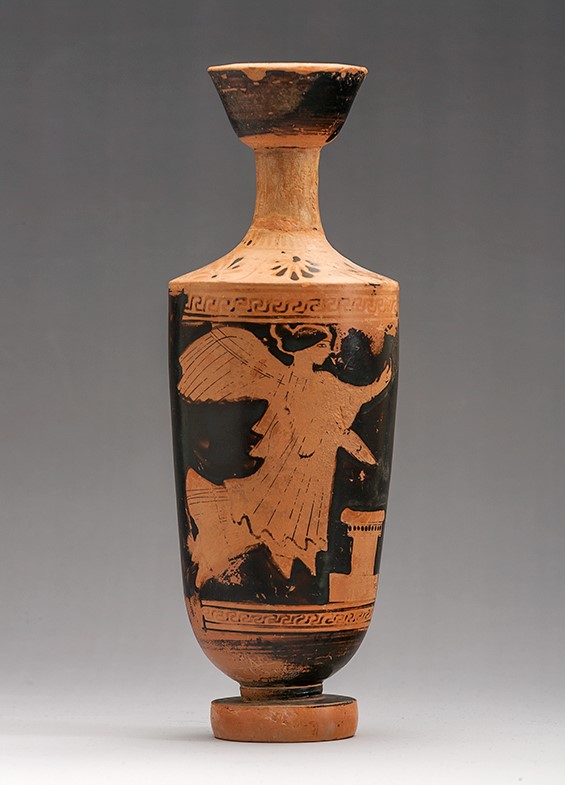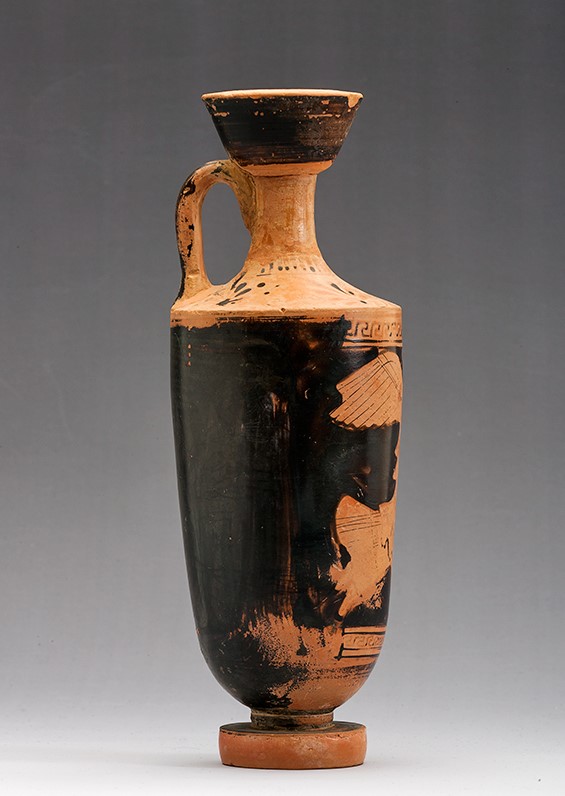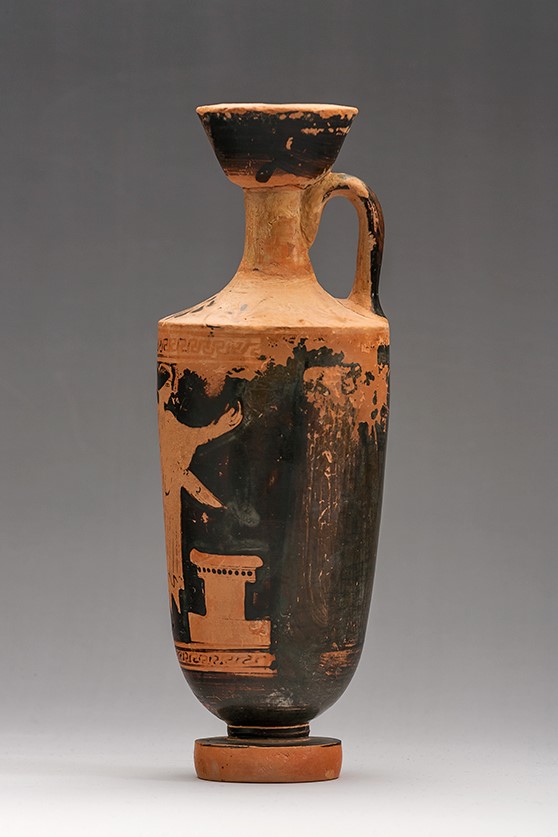Acquisition number: 1969.04
Attic Red-Figure Lekythos. The mouth is painted inside and out, but the top of the lip is reserved. The outer face of the handle is black. On the shoulder in black-figure are five linked palmettes with a zone of bars above. On the body a Nike is shown flying right towards an altar, a phiale in her right hand. One may suppose that she carried a fillet or sash in her left although no trace of the added colour in which it was painted remains.
Relief line is used throughout but there is no consistent use of relief contour. Above and below the scene is a band of simple meander. There are scraped grooves above and below the fillet between body and foot. The vertical face of the foot and the underside are reserved. All the reserved areas are reddened.
Title: Attic Red-Figure Lekythos - 1969.04
Acquisition number: 1969.04
Attribution: Bowdoin Painter.
Author or editor: J.R. Green
Culture or period: Attic Red-Figure.
Date: Mid 5th century BC.
Material: Clay - Terracotta
Object type: Pottery - Red-figure
Dimensions: 86mm (w) × 249mm (h)
Origin region or location: Greece
Origin city: Athens.
Display case or on loan: 3
Keywords: Greek, Attic, Red Figure, Bowdoin Painter, Nike, Victory
Folio Fine Art Ltd (London), Catalogue65 (July 1969) no. 733 (ill.); J.R. Green with B. Rawson, Catalogue of Antiquities in the Australian National University, A.N.U. (Canberra, 1981) 39; C. Thöne, Ikonographische Studien zu Nike im 5. Jahrhundert v. Chr. (Heidelberg 1999) 126-7 no. A 46. Beazley Archive Pottery Database 7651.
1969.04
Attic Red-Figure Lekythos
Purchased. Ht 24.9cm; diam. 8.6cm.
The neck and handle have been broken and re-joined but nothing is missing. The surface is worn.
The mouth is painted inside and out, but the top of the lip is reserved. The outer face of the handle is black. On the shoulder in black-figure are five linked palmettes with a zone of bars above. On the body a Nike is shown flying right towards an altar, a phiale in her right hand. One may suppose that she carried a fillet or sash in her left although no trace of the added colour in which it was painted remains.
Relief line is used throughout but there is no consistent use of relief contour. Above and below the scene is a band of simple meander. There are scraped grooves above and below the fillet between body and foot. The vertical face of the foot and the underside are reserved. All the reserved areas are reddened.
The vase may be attributed to the Bowdoin Painter, a specialist in lekythoi in the years towards the middle of the fifth century BC. (cf. J.D. Beazley, Attic Red-Figure Vase-Painters (2nd ed., Oxford 1963) 677ff. and Paralipomena: Additions to Attic Black-Figure Vase-Painters and to Attic Red-Figure Vase-Painters [Oxford 1971] 405-407). The flying Nike is one of his favourite motifs and such a subject would have made the lekythos a suitable gift for someone deserving of reward for some achievement whether in music, athletics or the field of battle (cf. T.B.L. Webster, Potter and Painter in Classical Athens [London 1972] 172ff.). See also C. Thöne, Ikonographische Studien zu Nike im 5. Jahrhundert v. Chr. (Heidelberg 1999) 126-127 no. A 46, who gives a list of comparable pieces, mostly by the Painter. Many of the Painter’s lekythoi have such black-figure palmettes on the shoulder and it is worth noting that the black-figure artist, the Athena Painter, may be the same as the Bowdoin Painter.
For an examination of the iconography of the goddess Nike, see Thöne, Ikonographische Studien zu Nike (with earlier references), and Lexicon Iconographicum Mythologiae Classicae vi, s.v. Nike; in the latter, for Nike approaching an altar with phiale, see nos 107-108, 111. More generally,note D. Musti, Nike. Ideologia, iconografia e feste della Vittoria in età antica (Rome 2005). The scene on this vase may be seen as an example of the growing move towards an expression of the excellence and the success of the individual, in this case the recipient of the vase (who could occasionally be named).
On the inclusion of altars in such scenes, see G. Ekroth, “Why (not) Paint an Altar? A Study of Where, When and Why Altars Appear on Attic Red-figure Vases”, in V. Nørskov, L. Hannestad, C. Isler-Kerényi and S. Lewis (eds), The World of Greek Vases (AnalectaRomInstDan, Suppl. 41, Rome 2009) 89-114.
Folio Fine Art Ltd (London), Catalogue65 (July 1969) no. 733 (ill.); J.R. Green with B. Rawson, Catalogue of Antiquities in the Australian National University, A.N.U. (Canberra, 1981) 39; C. Thöne, Ikonographische Studien zu Nike im 5. Jahrhundert v. Chr. (Heidelberg 1999) 126-7 no. A 46. Beazley Archive Pottery Database 7651.


